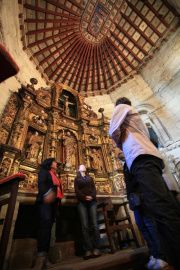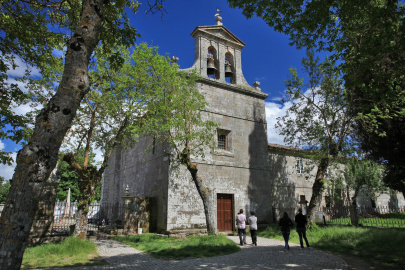

Church of San Salvador de Asma
It may be dated from the end of the 9th century. As in many Galician monasteries, a couple of nobles are the founders, given by double until the end of the 11th century. Cluny arrived there by means of the Benedictine order in the 12th century and governed within its walls until the end of its existence as a monastery.
It is kept an original document of donations that "Ermesinde", descendant of the founders made between the years 1066-1075. Up to the date of 1835, when its role as a monastery disappeared, the confiscation tried to erase its legacy. But we still have a few words of remembrance through Airas Moniz of Asma, a 12th century troubadour:
“E cuido-m´eu avergonhar!
Se vu prouguer´, debedes
Oj´a mía barbar a onrar,
Que sempr¨onrada sol andar.
E vos non mi-a viltedes!”
Characters of thin beards as who are referred to in the text fill its corbels. These are attributed to the master of Asma, who probably knew the work of master Esteban in the Cathedral of Santiago, or according to others, followed the master of Carboeiro.
It is true that we recognize his shapes, his whims, but also we see in Asma peacocks, squirrels, lions, vegetal and chess motifs decorating windows and the interior.
The present church is the result of different times; the apse is dated from the Romanesque of the 12th century and some corbels were reused in subsequent improvements. The current facade is from the 19th century. Although we can also find reused pre-Romanesque parts in windows and the interior, likely remains of the first building of the 9th century.
Inside it has a single-nave plan, with octagonal apse to the inside and covered with a coffered ceiling of the 16th century fruit of the accession to the Congregation of Valladolid. This is why it is decorated with its shield, and the nave is covered with wood. It stands out the wooden floor that no doubt used to have a funerary function.
The interior of the apse has three profusely decorated windows and an impost line with chess motifs goes over it. One of the three windows of the apse cannot be seen from the inside due to the altarpiece in polychrome wood also of the 16th century. It is dominated by El Salvador, where we can also see two delicate scenes from the Nativity and Adoration of the Magi, between images of an apostolate with St. Peter and Paul flanking the sanctuary.
We must also highlight the images of Santo Estevo and San Blas, as well as the altarpiece of San Benito very venerated in the parish. The Saint´ s Day is when the oil is blessed and later distributed among the faithful. The altarpiece hides the access door to the cloister of the old monastery, currently a private property which cannot be accessed.
The south door, which gives access to the cloister, may have the greater Romanesque tympanum of all the Ribeira Sacra, according to those who were able to see it. It represents two animal figures struggling in an artistic Arabesque. Sober semicircular archivolts frame it, having chess motifs the exterior one as we can see in windows and other parts of the temple.
A large triumphal arch with chess motifs adorns the interior and distributes the different spaces.
The north side has an altarpiece of the child Jesus of Praga.
It keeps the baptismal font from the medieval period.
San Salvador de Asma Church
Information and contact

Lugar Portada, 5
Chantada
27519 Lugo
 Directions
Directions 




 What would you improve?
What would you improve?